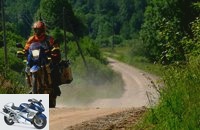Menus
Test Cagiva Canyon 600
Small ravines
Cagiva’s fun bike looks strong. But with 34 hp, the Canyon 600 seems to be a bit weak motorized for a big single.
A mixture of a Ducati 916 and a long-legged insect: a fun bike can hardly look more beautiful. Not only did all the journalists agree on this at the first presentation in Varese in autumn 1995, but also all members of the editorial team when Canyon arrived in Stuttgart. A front fairing with double headlights, integrated indicators, two rear silencers, placed symmetrically under the rear section – once again a typically Italian design.
Well-looking looks aren’t all that count. When looking at the technical data sheet, the enthusiasm is initially dampened. The same old, short-stroke, four-valve engine that did its job unspectacularly in the Enduro W 16 and the all-round bike River with a displacement of 601 cubic centimeters and a maximum of 34 hp. Bad prospects for rapid progress.
Buy complete article

Test Cagiva Canyon 600
Small ravines
Cagiva has a seat height of 860 millimeters for smaller people, and the large turning circle of just under five meters can sometimes be a nuisance when maneuvering. In addition, the initially comfortable, wide and thickly padded seat is not enough for long tours. After a few hours of driving, the upholstery pushes through and causes discomfort. Special praise goes to the lighting system. The double headlights not only look beautiful, they also donate good low beam and much better high beam.
Otherwise the equipment of the Canyon is only average. No adjustable hand levers, no main stand that would be very useful for easier maintenance of the chain, no luggage rack, although it was originally announced as standard equipment, no reserve tap. Although there is a speedometer and rev counter in the cockpit, a fuel gauge and a petrol lamp, in contrast to the speedometer, the petrol gauge is very imprecise. When the needle hits the red area, the 20 liter plastic tank holds more than ten liters. If the yellow warning lamp lights up, there is still six liters left to safely go to the nearest petrol station.
The Canyon is not at its best here. On average, between five and six liters of unleaded premium fuel per 100 kilometers is too much, and the two uncontrolled catalytic converters in the rear silencers are no comfort either.
In contrast, the price is acceptable. 9990 marks including all ancillary costs are rather below average what a fun bike costs today. Even if the Canyon only has 34 hp. But their performance is far stronger than the performance suggests.
Related articles
-
Comparison test of the Cagiva Gran Canyon against the Yamaha TDM 850
Comparison test Cagiva Gran Canyon against Yamaha TDM 850 The second face No one was like them: Enduro, athlete, tourer, fun bike ?? all in one. And…
-
Endurance test Cagiva Navigator
Bilski long-term test Cagiva Navigator Orientation level travel enduro or fun bike, which course is the Cagiva Navigator taking? 50,000 kilometers in …
-
Driving report: Cagiva Canyon 600
Driving report, Cagiva Canyon 600 Cagiva Canyon 600 This article is currently only available as a PDF download …
-
Comparison test Cagiva Navigator against Kawasaki ZRX 1100
Comparative test Cagiva Navigator against Kawasaki ZRX 1100 Die Urilpraktiker You want a comfortable street motorcycle with a good 100 HP, upright …
-
Comparison test all-rounder: Cagiva Navigator, Honda XL 650 V Transalp, Yamaha TDM 850
Comparative test of all-rounders: Cagiva Navigator, Honda XL 650 V Transalp, Yamaha TDM 850 The sighted drivers sit on it, start up, drive off. No matter if short …
-
Test Cagiva Gran Canyon 900 The power of feelings Forget the technical data, do not think in terms of ready-made patterns, forget terms like Enduro and …
-
Cagiva Canyon 600, Aprilia Pegaso 650 (VT)
Cagiva Canyon 600, Aprilia Pegaso 650 No matter how individualistic they are: Enduro riders are herd animals when choosing their motorcycles …
-
Cagiva Canyon 500 – Technical Specifications
Cagiva Canyon 500 technical data Overview Testing Technical specifications -Market offers Related articles Ducati 620 Sport – Technical Specifications…
-
Endurance test final balance: Aprilia RSV4 R
Bilski endurance test final balance: Aprilia RSV4 R The super sports car from Aprilia after 50,000 km After the start of superbike life for the RSV4 R …
-
Top-Test Honda Deauville She is one of those There are only a few motorcycles that can do almost everything from the factory except online banking. But maybe she learns …